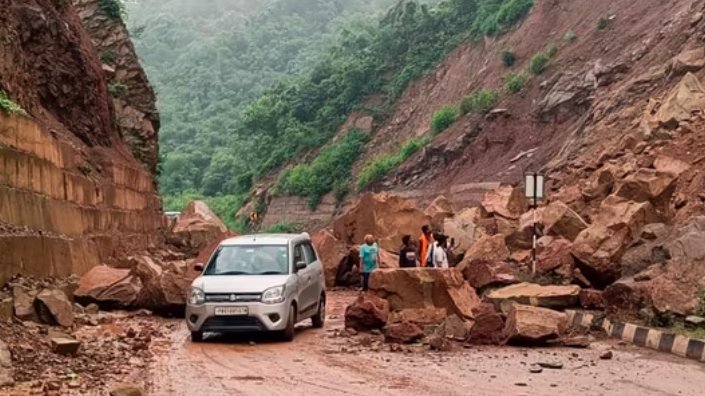A major landslide struck the A83 at Rest and Be Thankful in Argyll and Bute early on September 1, 2025, forcing the closure of the main road and its usual diversion route, the Old Military Road. This has left drivers facing a lengthy 60-mile detour, with emergency teams on site assessing the damage and planning cleanup amid ongoing weather concerns.
Landslide Triggers Immediate Road Closures
Heavy rainfall overnight led to a significant debris slide on the hillside above the A83, blocking the carriageway with rocks and mud. Traffic Scotland reported the closure around 8:30 AM local time, advising motorists to avoid the area entirely.
The Old Military Road, typically used as a backup during such events, was also deemed unsafe due to the risk of further slips. Police Scotland confirmed the shutdown affects both directions from Arrochar to the A815 at Dunoon, with initial diversions rerouted multiple times as conditions worsened.
This incident marks the latest in a series of disruptions at this notorious spot, where landslides have become more frequent due to steep terrain and unpredictable weather patterns. Local residents and commuters expressed frustration over the repeated closures, which disrupt travel between Glasgow and western Scotland.
Transport officials noted that geotechnical experts are inspecting the site in daylight to ensure safe clearance. Resources for cleanup are being mobilized, but no reopening timeline has been set yet.

Diversion Routes and Travel Impacts
With both primary routes closed, drivers must now follow an extended detour that adds significant time and distance to journeys. The current alternative path involves the A82 from Tarbet to Crianlarich, then the A85 and A819 back to the A83 at Inveraray.
This route stretches nearly 60 miles, compared to the usual 10-mile direct path, and is not suitable for heavy goods vehicles or buses. Police Scotland urged people to use even longer options if needed, such as routes via Lochgoilhead, but those were later closed due to additional slides.
Here are key details on the diversion:
- Start at Tarbet on A82 northbound.
- Proceed to Crianlarich, then join A85 westbound.
- At Dalmally, take A819 south to Inveraray and rejoin A83.
- Expect delays of up to two hours or more during peak times.
- HGVs should consider routes via the A82 to Fort William for safer passage.
Businesses in nearby towns like Arrochar and Inveraray report immediate economic hits, with reduced traffic affecting shops and tourism. Commuters heading to work or school faced chaos, with some turning back or seeking remote options.
History of Landslides and Ongoing Challenges
The Rest and Be Thankful section of the A83 has a long history of instability, with records of landslides dating back decades. Major events in 2020 saw over 10,000 tonnes of debris, prompting urgent mitigation efforts.
Transport Scotland has invested millions in solutions, including debris fences, catch pits, and hillside monitoring. Since 2014, more than £16 million has gone into clearing slips and assessments, yet closures persist during heavy rain.
Experts attribute the issues to climate change, with increased rainfall eroding the steep slopes. A government task force formed in 2012 continues to explore fixes, but progress has been slow amid funding debates.
Recent data shows an average of five major closures per year over the past decade, each lasting from hours to days. This pattern raises safety concerns for drivers and highlights the need for resilient infrastructure in rural Scotland.
Proposed Long-Term Solutions on the Horizon
In a bid to end the cycle of disruptions, the Scottish Government published draft orders in December 2024 for a long-term fix: a 1.4km debris flow shelter over the vulnerable road section. This structure would act like a tunnel, protecting against falling rocks.
The plan also includes upgrades to the Old Military Road for better resilience as a medium-term option. Public exhibitions started in January 2025, allowing community input on environmental impacts and designs.
However, building the shelter could close the A83 for years, sparking debate among locals who rely on the route. Costs are estimated in the hundreds of millions, with funding tied to broader transport budgets.
The table below outlines key proposed solutions and their timelines:
| Solution Type | Description | Estimated Timeline | Potential Cost |
|---|---|---|---|
| Debris Shelter | 1.4km protective structure over A83 | Construction start 2026-2027 | £200-300 million |
| Road Upgrades | Enhanced Old Military Road with bunds and pits | Phased work through 2025 | £50-80 million |
| Monitoring Tech | Advanced sensors for early landslide warnings | Already in progress | £5-10 million |
These measures aim to provide lasting relief, but implementation depends on approvals and weather cooperation.
Community Reactions and Safety Advice
Residents in Argyll and Bute voiced anger over the government’s handling, with some calling the A83 Scotland’s most unreliable road. Social media buzzed with stories of stranded travelers and calls for faster action.
One local business owner shared how repeated closures have cut revenue by 30 percent in bad weather seasons. Emergency services praised quick responses that prevented injuries, emphasizing the importance of heeding warnings.
For now, authorities recommend checking Traffic Scotland updates before traveling. With more rain forecast, further slips remain a risk.
As this story develops, share your experiences with similar road issues in the comments below, and pass this article along to help others stay informed.


















